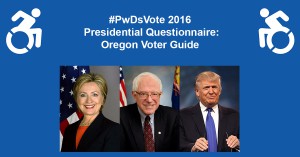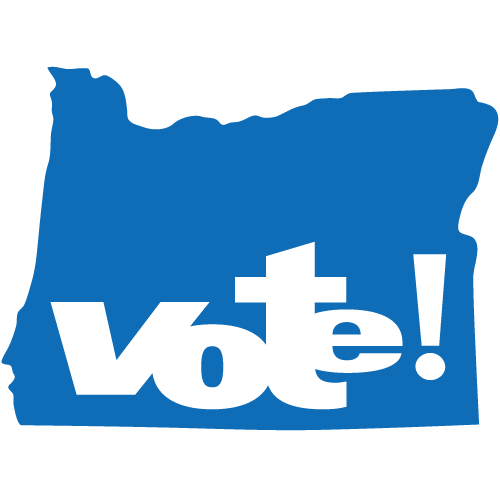State Working to Increase Collaboration between Vocational Rehabilitation Services and Other Workforce Organizations
 Washington, May 16 – As voters head to the polls in Oregon tomorrow, RespectAbility is sharing its Oregon Disability Voter Guide.
Washington, May 16 – As voters head to the polls in Oregon tomorrow, RespectAbility is sharing its Oregon Disability Voter Guide.
There are 571,982 people with a disability in Oregon, 274,900 of whom are of working age (between the ages of 21 and 64). There are an additional 14,000 people ages 16-20 with disabilities, many of whom are hoping to enter the workforce. Oregon’s voters are looking to know where the candidates stand on important disability issues in order to increase opportunities for competitive, integrated employment for people with disabilities.
The #PwDsVote 2016 Campaign Questionnaire was designed for people with disabilities (PwDs) and those who love them to know where candidates stand on the issues. The questionnaire asked all of the presidential candidates on both sides of the aisle to comment on 16 disability questions. Former Sec. of State Hillary Clinton and Sen. Bernie Sanders responded by addressing all of the questions. They each have significantly different views on the issues.
Despite numerous requests in person and by phone and email, presumptive Republican nominee Donald Trump has not yet filled out the questionnaire. However, several Republican candidates who have since dropped out of the race did respond to the questionnaire including former Gov. Jeb Bush, who addressed all of the questions, and Dr. Ben Carson, Gov. Chris Christie and Gov. John Kasich, all of whom filled out parts of the questionnaire.
RespectAbility is nonpartisan and does not endorse candidates. The questionnaire is purely for educational purposes as voters go to the polls.
Fully one-out-of-five voters have a disability, and 52 percent of likely voters have a loved one with a disability. Only 34 percent of working-age Americans with disabilities have jobs, despite the fact that the vast majority want to work. More than 11 million working age people with disabilities are now living on government benefits in our country.
RespectAbility President Jennifer Laszlo Mizrahi said, “Our community is looking for jobs so we can achieve the American dream, just like anyone else. It is vital for us to know where the candidates stand economic, stigma, education, safety, transportation, housing, healthcare, foreign affairs and other issues. The candidates have hugely different ideas about how to deal with the issues. Thus, it’s extremely important to read their full answers so you can understand their vast differences.”
Oregon currently holds a 36.4 percent labor force participation rate for people with disabilities and ranks 24th out of all fifty states. Other states, such as the Dakotas, have reached rates around fifty percent, showing that improving outcomes for people with disabilities is certainly possible when best practices are implemented. View the rankings of all 50 states and compare.
RespectAbility has submitted comments for all 50 state’s drafts of the Unified Plan as required under Section 102 of The Workforce Innovation and Opportunity Act (WIOA) and expects outcomes to improve for people with disabilities in Oregon, as their state plan indicates that they are making an effort to increase collaboration between vocational rehabilitation services and other workforce organizations. Additionally, there has been an emphasis placed on physical and programmatic accessibility at one-stop centers which will make services more readily available to those who require them. This is good news, as a recent detailed study by the Kessler Foundation and the University of New Hampshire shows the 70 percent of working-age people with disabilities are striving for work.
Oregon also has been notably transparent in regards to their WIOA changes. Upon submitting RespectAbility’s comments concerning the state plan, Oregon responded with a template of their own which addresses the comments made not only by RespectAbility, but all other organizations and individuals that submitted comments. The template of notes can be foundhere.
However, the gap in the labor force participation between people with and without disabilities in Oregon is 38.5 percent. This lack of employment for people with disabilities creates poverty, powerlessness, and poor health. Polls and studies show that people with disabilities want the opportunity to have the dignity and independence that jobs provide.
America has 1.2 million youth with disabilities, between the ages of 16 and 20. Each year 300,000 of them age into what should be the workforce, but stigmas and lack of knowledge about the capabilities of people with disabilities means that most do not find employers willing to hire them. Young adults with disabilities in all of these states are hoping to find work. They have high expectations and deserve the opportunity to achieve the American dream. Young people with disabilities may simply need some thoughtful help to transition into the workforce. See data on all 50 states here: State Data.
RespectAbility will continue to urge Trump to submit his ideas for the disability community. When he does so, RespectAbility will update the guide. The questionnaire is being distributed to more than 50,000 people who care about disability issues, more than ten thousand of whom live in the early primary states and the heads of more than 100 national disability organizations, many of whom will share with their own lists. RespectAbility also has placed online ads sharing the questionnaire.






Be First to Comment